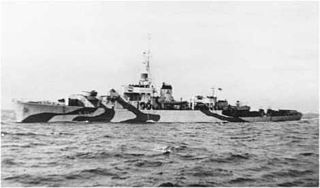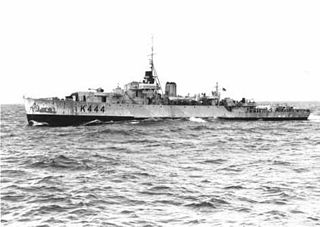
HMCS Eastview was a River-class frigate that served in the Royal Canadian Navy from 1944-1946. She served as a convoy escort in the Battle of the Atlantic. She was named after the Ottawa suburb of Eastview.

HMCS Charlottetown was a River-class frigate that served with the Royal Canadian Navy (RCN) during the Second World War. She was the second vessel of the name, HMCS Charlottetown having been a Flower-class corvette that had been sunk earlier in the war. They are unique for being the only two ships to have shared the same pennant number, K 244. She was named for Charlottetown, Prince Edward Island.

HMCS Cape Breton was a River-class frigate that served the Royal Canadian Navy (RCN) during the Second World War. She served primarily as a convoy escort in the Battle of the Atlantic during the war. She was named for Cape Breton Island in Nova Scotia. She was the first to carry her name, HMCS Cape Breton was the second.

HMCS Royal Mount was a River-class frigate that served with the Royal Canadian Navy during the Second World War. She was used primarily as an ocean convoy escort in the Battle of the Atlantic. She was named for Mount Royal, Quebec, however due to possible confusion with HMCS Montreal, her name was switched around.

HMCS Grou was a River-class frigate that served with the Royal Canadian Navy during the Second World War. She served primarily as an ocean convoy escort in the Battle of the Atlantic. She was named for Jean Grou, a Roman Catholic martyr from Pointe-aux-Trembles, Quebec. The town's name was considered too long for a warship, so they chose something that was significantly tied to it.

HMCS Joliette was a River-class frigate that served with the Royal Canadian Navy during the Second World War. She served primarily as a convoy escort in the Battle of the Atlantic. She was named for Joliette, Quebec. After the war she was transferred to the Chilean Navy in 1946 and renamed Iquique. She served with the Chilean Navy until 1968.

HMCS Jonquière was a River-class frigate that served with the Royal Canadian Navy during the Second World War and again from 1954–1966 as a Prestonian-class frigate. She was named for Jonquière, Quebec.

HMCS Valleyfield was a River-class frigate that served with the Royal Canadian Navy during the Second World War. She served primarily as a convoy escort in the Battle of the Atlantic. She was torpedoed and sunk in May 1944, the only River-class frigate lost by the RCN. She was named for Salaberry-de-Valleyfield, Quebec.

HMCS LaSalle was a River-class frigate that served with the Royal Canadian Navy during the Second World War. She served primarily as a convoy escort in the Battle of the Atlantic and in the Battle of the St. Lawrence. She was named for LaSalle, Quebec.

HMCS Lévis was a River-class frigate that served with the Royal Canadian Navy during the Second World War. She served primarily as a convoy escort in the Battle of the St. Lawrence and the Battle of the Atlantic. She was the second ship to bear the name of Lévis, the first being a Flower-class corvette that had been sunk earlier in the war. She was named for Lévis, Quebec.

HMCS Montreal was a River-class frigate that served with the Royal Canadian Navy during the Second World War. She served primarily as an ocean convoy escort in the Battle of the Atlantic. She was named for Montreal, Quebec.

HMCS Outremont was a River-class frigate that served with the Royal Canadian Navy during the Second World War and again from 1955–1965 as a Prestonian-class frigate. During the war she served primarily as a convoy escort. She was named for Outremont, Quebec.

HMCS Prince Rupert was a River-class frigate that served with the Royal Canadian Navy during the Second World War. She served primarily as a convoy escort in the Battle of the Atlantic. She was named for Prince Rupert, British Columbia.

HMCS Runnymede was a River-class frigate that served with the Royal Canadian Navy during the Second World War. She served primarily as a convoy escort in the Battle of the Atlantic. She was named for York, Ontario, however due to possible confusion with HMCS West York, her name reflects a connection with that community.

HMCS Kirkland Lake was a River-class frigate that served with the Royal Canadian Navy during the Second World War. She served primarily as a convoy escort in the Battle of the Atlantic. She was named for Kirkland Lake, Ontario.

HMCS St. Pierre was a River-class frigate that served with the Royal Canadian Navy during the Second World War. She saw action as a convoy escort during the Battle of the Atlantic. She was named for Havre-Saint-Pierre, Quebec, whose name was shortened due to its length. After the war she was sold to Peru and renamed Teniente Palacios in 1947.

HMCS St. Catharines was a River-class frigate that served with the Royal Canadian Navy during the Second World War. She served primarily as a convoy escort in the Battle of the Atlantic. She was named for St. Catharines, Ontario. After the war she was re-purposed as a weather ship for use by the Department of Transport of Canada.

HMCS Stone Town was a River-class frigate that served with the Royal Canadian Navy during the Second World War. She served primarily as a convoy escort in the Battle of the Atlantic. She was named for St. Marys, Ontario, however there was already a ship by that name within the Commonwealth navies so they chose the nickname of the town for its representation. After the war she was re-purposed as a weather ship for use by the Department of Transport of Canada.

HMCS Matane was a River-class frigate that served with the Royal Canadian Navy during the Second World War. She served primarily as a convoy escort in the Battle of the Atlantic. She was named for Matane, Quebec.

HMCS Thetford Mines was a River-class frigate that served with the Royal Canadian Navy during the Second World War. She served primarily as a convoy escort in the Battle of the Atlantic. She was named for Thetford Mines, Quebec.




















